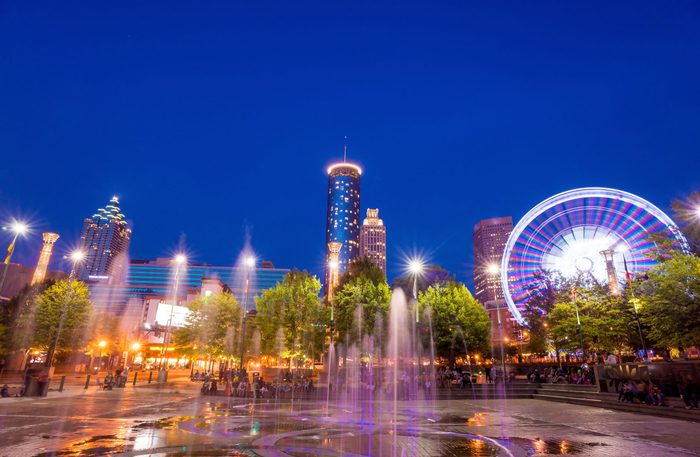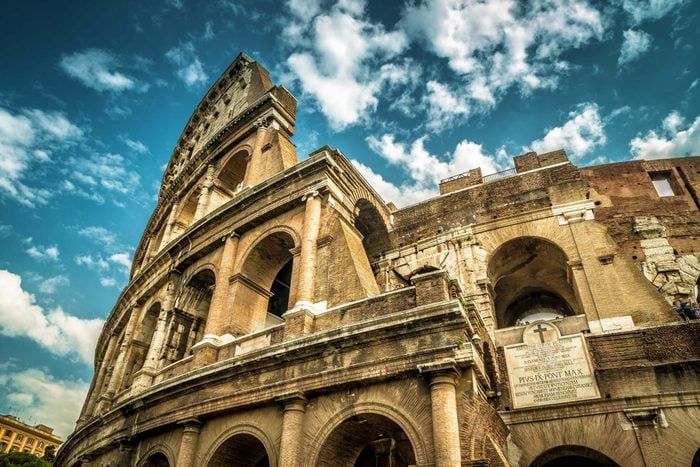
1. London, Great Britain – 2012
The 2012 Summer Games made London the first and only city to play host to the Olympics on three occasions (it also hosted in 1908 and 1948). A mix of established facilities, historic sites and temporary venues welcomed athletes from around the globe, while the tourist-friendly Hyde Park, Horse Guards Parade and the Mall held events like the triathlon, beach volleyball and the marathon. The Olympic Stadium and London Velodrome saw many memorable moments as well, and the 200-hectare Queen Elizabeth Olympic Park in East London is easily one of the most ambitious venues built for the Olympic Games.

2. Montreal, Canada – 1976
Montréal’s Summer Olympics introduced the world to Nadia Comaneci—the first athlete to earn a perfect 10 in gymnastics. But it wasn’t just Nadia’s accomplishments that impressed Olympic watchers that year. The innovative architecture of Montréal’s Olympic Park set a new standard for Games venues. Designed by French architect Roger Taillibert, the Olympic Stadium and its exquisite inclined tower—the tallest in the world—showcased a modern look for the Games. Today, the stadium and tower continue to attract athletes, sports fans, concert-goers and tourists the world over.
Discover 10 great day trips from Montreal.

3. Beijing, China – 2008
Beijing raised the bar for all future Olympic Games (over 130 Olympic records were shattered there). The woven appearance and steel beams of the Beijing National Stadium led to the affectionate nickname “The Bird’s Nest.” The 80,000-seat venue hosted the opening and closing ceremonies, athletics and the football final. The Beijing National Aquatics Center was another enthralling arena. Playfully referred to as “The Water Cube,” its external walls were designed to look like a configuration of soap bubbles. American Michael Phelps famously won eight gold medals—the most medals won during a single Olympic Games.
Check out our round-up of the best street foods across Asia.

4. Atlanta, USA – 1996
1996 marked the Olympics’ 100th anniversary and it was believed that Athens, the birthplace of the Games, had a lock on hosting duties. Surprisingly, Atlanta won the bid, perhaps due to the guarantee of lucrative TV revenues and a forward-thinking attitude towards the Games. The cost-efficient, 85,000-seat Centennial Olympic Stadium was the focal point of the 1996 Games. Designed with its post-Olympic future in sight, the stadium was equipped with luxury boxes and multiple tiers of outfield seats, as well as an area destined to become a baseball infield. Today, the Olympic Stadium enjoys its second life as Turner Field.
You won’t want to miss these 12 airports that are also overlooked landmarks.

5. Athens, Greece – 2004
Greece has a connection to the Olympic Games that no country can match. From 776 B.C. to 393 A.D., the ancient Games were based in Olympia. The first modern Olympic Games kicked off in Athens during 1896. With the arrival of the 2004 event, the Olympics returned home. The 2004 Athens Summer Games didn’t spare any expense to celebrate the Olympics’ exciting past and present. Marathon runners raced along the same course that was used for the 1896 Games. Archers took aim in the ancient Panathinaiko Stadium, and the shot put event hurled into action on the grounds of the old Olympia Stadium.
Plan your travel itinerary with the 12 best things to do in Greece.

6. Barcelona, Spain – 1992
Barcelona’s 1992 Summer Olympics were a slam dunk. Men’s basketball included professional players for the first time and the U.S. Dream Team won the gold medal. Famous athletes aside, Barcelona benefitted greatly. The construction of the Olympic Village resulted in the creation of new sandy beaches, stunning hotels, an engaging port and picturesque venues like the Barcelona Olympic Stadium. Originally built in 1927, the eye-catching stadium was a mix of the old and the new. Today, tourists and locals can still enjoy the stunning architecture and beaches the Olympics brought to the city.
Prepare to be awed by the 35 most beautiful structures in the world.

7. Los Angeles, USA – 1984
After the financial woes of the 1976 Games, Los Angeles placed the sole bid to host the 1984 Olympics. The Rose Bowl and Los Angeles Coliseum, both used during the 1932 Games, were utilized along with 29 other facilities already in existence. Only two new venues were built for the Games: the Velodrome and the Swim Stadium. The iconic Los Angeles Coliseum, built in 1923, holds the distinction of being the only sports facility to have seen two Olympic Games, multiple Super Bowls, and the World Series. Today, sports fans can still see the Coliseum’s Olympic Cauldron ablaze during USC football games.
How many of these top bucket list destinations have you been to?

8. Moscow, USSR – 1980
The Moscow Summer Olympics is best remembered for a boycott that saw over 65 nations, including the USA, Canada and China, skip the 1980 Games. Despite the political unrest, the first Olympics held in a communist country proceeded with great fanfare. The centerpiece was the Grand Sports Arena of the Luzhniki Olympic Complex. During the Games, the stadium’s capacity swelled to 103,000 as it hosted the opening and closing ceremonies, as well as several events. It has recently proved popular for concerts, as well as sporting events like the 2008 Champions League final and the 2018 World Cup final.
Don’t miss these incredible photos of abandoned subway stations around the world.

9. Sydney, Australia – 2000
Ushering in the new millennium, Sydney’s 2000 Summer Olympic Games were hailed as one of the best ever. Its world-class venues boasted environmental features to conserve energy, save water and reduce pollution. The heart of the action was Stadium Australia (now called the ANZ Stadium). At the time of the 2000 Olympics, it was the largest outdoor venue ever built for the Games. Four Boeing 747s could fit side-by-side under the stadium’s arches. Designers were able to protect spectators and TV cameras from the strong Aussie sun—all without closing the roof and shutting out Australia’s glorious climate.
Test your knowledge with these 30 most common geography mistakes.

10. Rome, Italy – 1960
The Eternal City provided a visually stunning and historic location for the 1960 Summer Games. The Basilica of Maxentius, the Caracalla Baths, Via Appia Antica, the Arch of Constantine and Via Cassia were among the ancient Roman venues used for the Games. The juxtaposition of these ancient backdrops with modern structures built for the Games created a distinctive atmosphere that was almost impossible to replicate elsewhere. It was here in this magical setting that a young American boxer named Cassius Clay (later known as Muhammad Ali) first made a name for himself, winning the light-heavyweight gold medal.
Next, check out 12 awesome Canadian attractions you’ve never heard of.